
Pregiati strumenti di misura per il controllo di qualità nella sala metrologica e nei reparti di produzione, accettazione merci o sviluppo.
Gear Metering Pumps & Meter Mix Dispense Machines with highest accuracy for processing liquids and pastes.
High-precision rotary stroke bearings for backlash-free linear and rotational movements for use in machine and device construction.
per cilindri Tecnologia di misura di forma e posizione Tecnologia di misura alberi Tecnologia di misura degli ingranaggi Metrologia ottica Portale delle macchine usate




















Experience the latest products in measurement technology, from digital calipers to fully automated inline solutions ✓newest features ✓highest quality




As an internationally active company, Mahr holds its patents not only in Germany, but worldwide.







Innovativi strumenti di misura portatili Mahr: Calibri a corsoio, micrometri e comparatori in versione analogica o digitale con trasmissione radio integrata. I comparatori e i campioni di riferimento Mahr sono indispensabili per la metrologia industriale di precisione.

Dall'analogico al digitale, tutta la gamma di calibri a corsoio. Facili da usare, ad alta precisione e senza cavi. Perfetti per un uso efficiente in ambiente produttivo.

I nostri calibri a corsoio digitali si distinguono per il display digitale di facile lettura, il design moderno e l'abituale precisione Mahr. L'assortimento comprende strumenti di misura per tutte le applicazioni. Le varie interfacce di trasmissione dati e il grado di protezione fino a IP 67 soddisfano tutte le esigenze.

Lettura antiriflesso, acciaio temprato, guide di scorrimento rialzate a protezione della scala e massima precisione. Le caratteristiche di un calibro a corsoio di qualità Mahr con il classico nonio.

Grande quadrante a forte contrasto e sistema di misura antiurto per una precisione duratura. Il classico meccanico per una lettura veloce e sicura.

Massima precisione e ampia varietà di modelli. I micrometri Mahr sono disponibili nella classica variante meccanica o in versione digitale e wireless.

I nostri micrometri digitali per esterni si distinguono per il display digitale di facile lettura, il design moderno e l'abituale precisione Mahr. L'assortimento comprende strumenti di misura per tutte le applicazioni. Le varie interfacce di trasmissione dati e l'elevato grado di protezione fino a IP 65 soddisfano tutte le esigenze.

Lettura antiriflesso, pannelli termoisolanti e un mandrino rettificato di precisione per la massima accuratezza. Le caratteristiche di un micrometro di qualità Mahr.

Particolarmente indicato per un test rapido e sicuro di parti di serie (alberi, bulloni, perni). La precisione dimensionale può essere letta a colpo d'occhio utilizzando il misuratore millesimale.
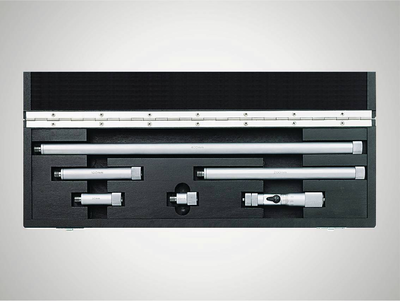
Per misurare diametri grandi e controllare distanze fino a 2500 mm

Con indicazione analogica o digitale, a scelta, o come strumento di misura rapido con impugnatura a pistola. Gli alesametri Mahr a 3 punti di contatto forniscono sempre risultati di misura affidabili grazie all'autocentraggio automatico.

Lettura antiriflesso e mandrino rettificato di precisione per la massima accuratezza. Le caratteristiche di un micrometro di qualità Mahr.

Dall'analogico al digitale, tutta la gamma di comparatori, misuratori millesimali e comparatori a leva. Facili da usare, ad alta precisione e con wireless opzionale. Perfetti per un uso efficiente in ambiente produttivo.

I nostri comparatori digitali si distinguono per il display digitale di facile lettura, la struttura robusta e l'alta precisione Mahr. L'assortimento comprende strumenti di misura per tutte le applicazioni. Le varie interfacce di trasmissione dati e l'elevato grado di protezione fino a IP 54 soddisfano tutte le esigenze.

Alta sensibilità e precisione garantite da: solido supporto degli assi del sistema di misura, pignone e ruota dentata di precisione, perno montato in modo ultrapreciso.

Alta sensibilità e precisione garantite da: solido supporto degli assi del sistema di misura, pignone e ruota dentata di precisione, perno montato in modo ultrapreciso

Rispetto ai comparatori analogici, i misuratori millesimali Millimess sono caratterizzati da componenti ancora più precisi, da una maggiore accuratezza e da un errore di inversione molto inferiore. Questi vantaggi emergono particolarmente nei controlli di oscillazione radiale, nelle misure di rettilineità e planarità e nelle misure comparative.

I misuratori millesimali induttivi ad alta precisione Millimess raggiungono risoluzioni fino a 0,2 μm. Le pratiche funzioni di comando, come il controllo delle tolleranze, il rilevamento del minimo o del massimo nelle misure dinamiche, l'indicazione numerica e analogica combinate e la facile trasmissione dei dati, ne fanno uno strumento di misura di precisione indispensabile.

Lo strumento di misura, ottimizzato al computer, garantisce la massima sicurezza e precisione. Per l'uso in officina il display è perfettamente protetto contro graffi o rotture da un quadrante di vetro minerale temperato e contro l'infiltrazione di liquidi da una guarnizione.

I nostri comparatori a leva digitali si distinguono per il display digitale di facile lettura, la struttura robusta e l'alta precisione Mahr.

I tastatori di misura 3D Mahr per macchine a CN, centri di lavoro e macchine a elettroerosione riducono i tempi di preparazione e di fermo macchina. Perfetti per la tastatura precisa dei bordi di riferimento su pezzi e dispositivi.

Indipendentemente dallo standard di interfaccia utilizzato (Integrated Wireless, moduli radio esterni, USB, Opto RS232 o Digimatic), MarConnect stabilisce sempre la connessione ideale.

Numerosi strumenti di misura portatili Mahr dispongono di un'uscita dati con interfaccia MarConnect. Indipendentemente da quale standard di interfaccia utilizziate (USB, Opto RS232 o Digimatic), MarConnect stabilisce sempre la connessione ideale.

L'assortimento wireless di Mahr assicura risultati di misura accurati con la massima libertà di movimento. Misurate in modo semplice e moderno senza essere limitati dai cavi

Gli stativi, le tavole di misura e gli strumenti per controlli di eccentricità MarStand garantiscono risultati di misura precisi grazie alla loro stabilità. I vostri comparatori, misuratori millesimali, comparatori a leva e tastatori di misura troveranno qui il supporto necessario.
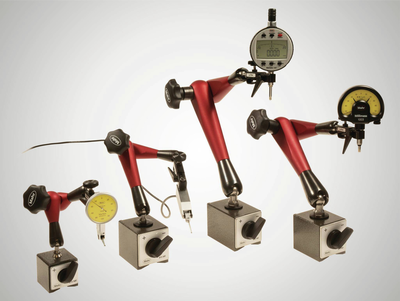
Gli stativi garantiscono risultati di misura precisi grazie alla loro stabilità. I vostri comparatori, misuratori millesimali, comparatori a leva e tastatori di misura troveranno qui il supporto necessario.
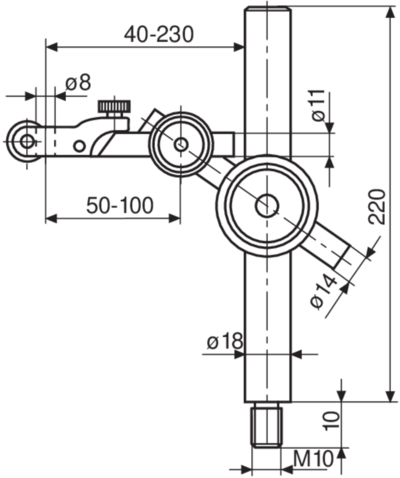
Le aste di misurazione MarStand si utilizzano per soluzioni personalizzate e garantiscono risultati di misura precisi grazie alla loro stabilità. Comparatori, misuratori millesimali, comparatori a leva e tastatori di misura troveranno qui il supporto necessario.

Le tavole di misura sono perfettamente piane e comprendono una colonna di misura stabile e bracci robusti. Le tavole di misura MarStand garantiscono risultati di misurazione precisi grazie alla loro grande stabilità.

Gli strumenti per controlli di eccentricità rappresentano il metodo più semplice per rilevare gli errori di forma e posizione sugli alberi nell'ambiente di produzione. Grazie alla varietà di modelli, i robusti strumenti per controlli di eccentricità MarStand costituiscono la base per soddisfare gli svariati requisiti dei pezzi e ottenere risultati di misura precisi.
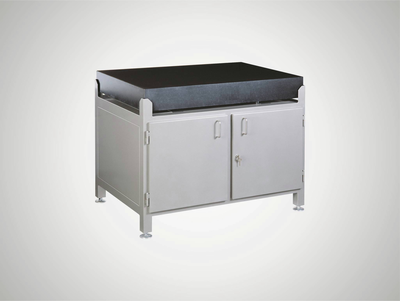
I piani di riscontro in granito costituiscono la base perfetta per i vostri altimetri grazie all'elevata resistenza e stabilità dimensionale.

Gli strumenti di misura con visualizzatore, utilizzati come comparatori, sono perfetti per le misure di precisione in fase di produzione. La regolazione in base a un campione di riferimento diminuisce le deviazioni e riduce al minimo l'influenza delle oscillazioni di temperatura sul risultato di misura.

Le forcelle a comparazione sono strumenti di misura perfetti per misurazioni di precisione di pezzi cilindrici quali alberi, bulloni e perni e in particolare per controlli sicuri e veloci su pezzi di serie. La precisione dimensionale può essere letta con sicurezza a colpo d'occhio utilizzando il misuratore millesimale.

Gli alesametri sono gli strumenti perfetti per le misure di precisione di diametro, rotondità e conicità nei fori.

La nostra gamma di misuratori di spessore comprende strumenti robusti e semplici per misurare molto velocemente lamine, lamiere e piastre di qualsiasi tipo.

Quando i comuni strumenti, come per es. i calibri a corsoio o i micrometri per interni, non possono essere utilizzati a causa della geometria del pezzo, gli strumenti di misura portatili rappresentano la soluzione perfetta!
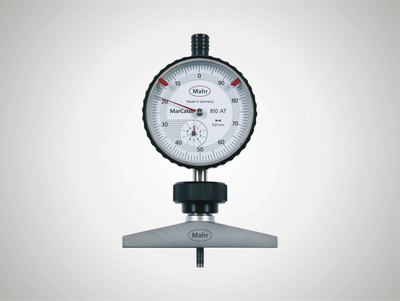
La nostra gamma di ponti per misure di profondità comprende strumenti robusti e semplici per misurare molto velocemente la profondità. Il codolo di serraggio di 8 mm permette l'uso di comparatori, misuratori millesimali e tastatori a seconda dell'operazione di misura da eseguire.

Gli strumenti universali sono i partner perfetti per le misure di precisione in fase di produzione poiché la misura comparativa rispetto a un campione di riferimento riduce al minimo l'influenza delle oscillazioni di temperatura sul risultato di misurazione.

Ingranaggi, filettature, coni o scanalature: gli strumenti di misura universali Multimar offrono una soluzione ottimale per quasi tutte le misurazioni interne ed esterne che non possono essere eseguite con apparecchi standard. Sono quindi a vostra disposizione diversi strumenti base e una vasta gamma di accessori.

Regolate con precisione i vostri strumenti di misura per interni ed esterni. Con gli apparecchi di preset 844 S sarete ben attrezzati per qualsiasi operazione di misura – anche per maggiori dimensioni.

Spallamenti di centraggio, spallamenti stretti o scanalature: gli strumenti di misura universali Multimar 36B offrono una soluzione ottimale per quasi tutte le misure interne ed esterne. Sono quindi a vostra disposizione diversi strumenti base e una vasta gamma di accessori.

Affidatevi ai campioni e ai calibri Mahr - la base per ottenere risultati di misura precisi.

Affidatevi ai campioni di calibrazione Mahr - la base per ottenere risultati di misura precisi.

I blocchetti piano paralleli di Mahr sono campioni di riferimento e di lavoro di alta qualità. Scegliete tra 4 classi di tolleranza e 2 materiali per adattarli alla vostra officina e al vostro reparto di produzione o di controllo qualità.

Le spine calibrate di Mahr sono disponibili in 3 classi di tolleranza e in varie versioni. Sceglietele in base alla vostra officina e al vostro reparto di produzione o di controllo qualità.

I requisiti dei misuratori elettrici di lunghezza sono molteplici così come le loro applicazioni. massima affidabilità e precisione e un uso semplicissimo.
I requisiti dei misuratori elettrici di lunghezza sono molteplici così come le loro applicazioni. massima affidabilità e precisione e un uso semplicissimo. Gli strumenti di misura Millimar, compatti e a colonna, soddisfano proprio questi requisiti.
I misuratori di lunghezza Millimar sono compatti, robusti e facili da usare. Sono apparecchi di analisi e visualizzazione di impiego versatile per operazioni di misura di complessità gestibile nell'ambiente di produzione e nella sala metrologica.

Grazie alle molteplici possibilità di combinazione di moduli e software, avrete l'opportunità di personalizzare più che mai l'ambiente di lavoro e gli utensili.
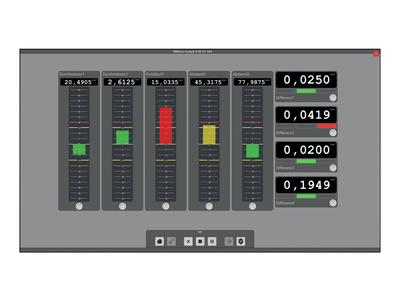
Software universale e intelligente per operazioni di misura complesse in ambienti di produzione

I trasduttori Millimar sono i componenti più importanti della catena di misura. Le loro caratteristiche determinano la qualità dell'intera misurazione. A seconda dell'applicazione sono disponibili tecnologie diverse. Per esempio, i tastatori di misura induttivi Millimar: costruzione solida, impiego flessibile e prezzo interessante.

Misure di spessore, oscillazione radiale o concentricità: i tastatori induttivi permettono di rilevare i valori di misura e gli scostamenti indipendentemente dalla forma, dall'appoggio o dagli errori di oscillazione radiale. Il loro grande vantaggio è rappresentato dall'ampio campo di linearità e dalla relativa insensibilità ai fattori di disturbo. I tastatori sono principalmente utilizzati per misure comparative in fase di produzione, ma le funzioni specifiche del sensore possono variare.
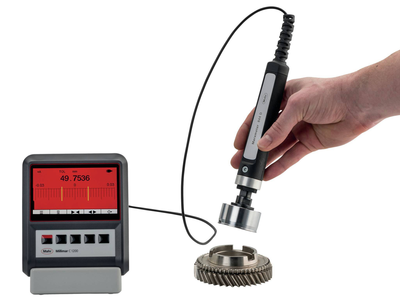
I misuratori per fori sono ideali per il controllo rapido di diametro, rotondità e conicità nei fori. Poiché, come negli altri alesametri, di solito non occorre cercare il punto di inversione, sono particolarmente adatti per l'uso con visualizzatori digitali e per l'ulteriore elaborazione dei valori di misura.

I misuratori di lunghezza pneumatici si distinguono per l'elevata precisione e la stabilità a lungo termine. La misura senza contatto tramite ugelli non danneggia i pezzi. Inoltre è possibile misurare pezzi sporchi, oliati, lubrificati o lappati con sicurezza e senza problemi, poiché le zone da misurare vengono pulite dal getto d’aria.
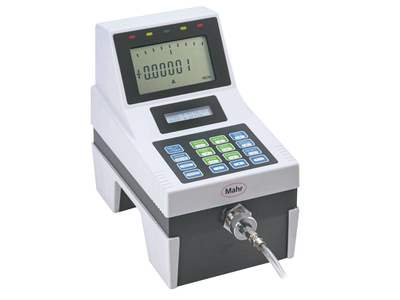
I misuratori di lunghezza Millimar sono compatti, robusti e facili da usare. Sono apparecchi di visualizzazione e analisi di impiego versatile per operazioni di misura di complessità gestibile nell'ambiente di produzione.

I risultati di misura sono visualizzati su 101 diodi luminosi a tre colori – facilissimi da leggere anche a distanza. Il superamento dei limiti di attenzione e tolleranza programmabili è segnalato con un cambio di colore dei segmenti dal verde al giallo o al rosso.

Gli strumenti di misura pneumatici Millimar rilevano gli errori dimensionali in modo rapido e preciso. Da anni si sono affermati come misuratori pneumatici di lunghezza di alta qualità nella produzione industriale e nella sala metrologica.

Quando la misura e l'analisi devono essere eseguite in mobilità.

Misura senza contatto con anelli pneumatici, nessun danno ai pezzi.

Adattate la stazione di misura all'operazione da eseguire utilizzando gli accessori per strumenti pneumatici.

Affidatevi ai campioni di calibrazione Mahr - la base per ottenere risultati di misura precisi

Regolazione di strumenti di misura pneumatici (anelli pneumatici). Accuratamente temprati, invecchiati, rettificati e lappati.

Regolazione di strumenti di misura pneumatici (tamponi pneumatici). Accuratamente temprati, invecchiati, rettificati e lappati.

Le livelle elettroniche offrono una risposta veloce, una risoluzione fine e un'eccellente ripetibilità.

Quando lo standard non basta più: soluzioni personalizzate in base alle esigenze del cliente

Con le vostre misurazioni mirate in alto? Per questo esiste Digimar!

Per la tracciatura e la marcatura dei pezzi in officina. Facile misurazione di altezze e distanze.
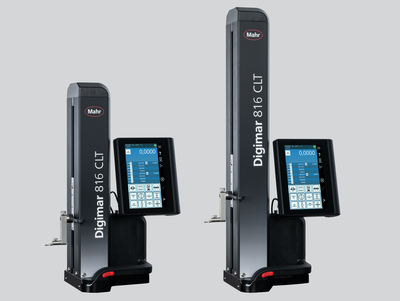
Touch operation, ergonomic handling and a wide range of evaluation options: This is what the Digimar 816 CLT height measuring device stands for.
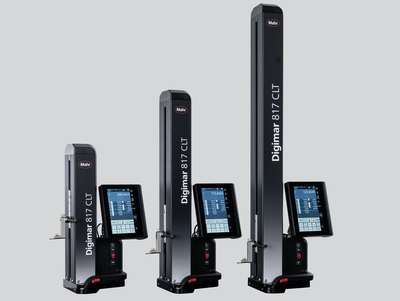
Comando tramite touchscreen, gestione ergonomica e un'ampia gamma di opzioni di valutazione: queste sono le caratteristiche dell’altimetro Digimar 817 CLT.

I misuratori di lunghezza si distinguono per la metrologia dimensionale ad altissima precisione - per misure assolute e relative.
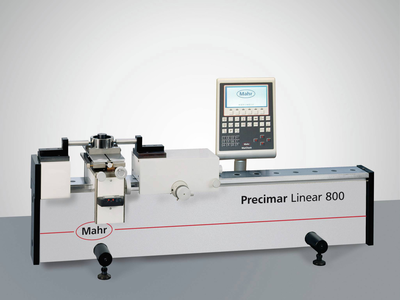
Misuratori di lunghezza e apparecchi di preset universali e facili da utilizzare per la produzione
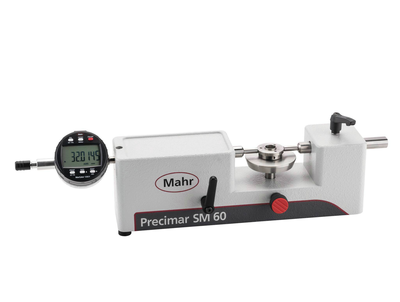
Misuratori di lunghezza e apparecchi di preset universali e facili da utilizzare per la produzione

Con la sua vasta gamma di prodotti, dal semplice banco di prova blocchetti, al banco completamente automatico di prova comparatori, dagli strumenti ULM alla macchina di misura universale CiM, ultraprecisa e semiautomatizzata, Mahr offre sempre soluzioni molto flessibili per la produzione, la sala metrologica e i laboratori di calbrazione. In altre parole, metrologia ad alta precisione con processi di misura molto efficienti.

ULM classici o strumenti PLM e CiM motorizzati. Le macchine di misura lineare universali consentono una misurazione facile, veloce e sicura con la minima incertezza.

Controllo semiautomatizzato e completamente automatico di comparatori, comparatori a leva, misuratori millesimali e tastatori - in modo efficiente e preciso.

Controllo semiautomatizzato e completamente automatico di comparatori, comparatori a leva, misuratori millesimali e tastatori - in modo efficiente e preciso.

Controllo manuale di comparatori, comparatori a leva e misuratori millesimali - semplicità e precisione

Affidatevi ai banchi di prova blocchetti Mahr - la base per il controllo preciso dei vostri campioni

I microscopi sono utilizzati in quasi tutti i settori per il controllo rapido di distanze, raggi e angoli. In laboratorio o in ambiente di produzione.

I microscopi sono utilizzati in quasi tutti i settori per il controllo rapido di distanze, raggi e angoli. In laboratorio o in ambiente di produzione.

Stereo microscopi dotati di zoom con ottica di alta qualità per immagini tridimensionali nitide e ad alta luminosità. Binoculare o trinoculare con uso supplementare di fotocamere digitali.

Rugosimetri per l'industria e la ricerca

Le superfici funzionali strutturate con tolleranze strette richiedono sistemi di misura ad alta precisione che registrino in breve tempo l'intera topografia di un pezzo o di un oggetto.

La tecnologia di misura dei profili 2D serve a determinare le deviazioni di forma grossolana.


Misurazione precisa dei profili 2D con gli strumenti di misura ottici

Misure di rugosità e profili 2D combinate: il professionista per tutte le applicazioni
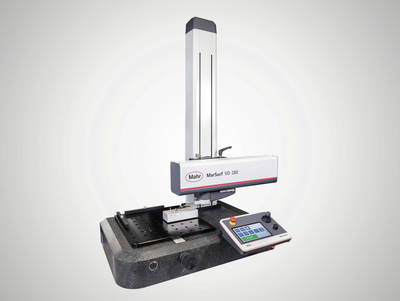
Misure di rugosità e profili 2D combinate: il professionista per tutte le applicazioni

Misura di profili 2D/3D e di rugosità secondo ISO 25178 / ISO 4287

Rugosimetri 3D per l'industria e la ricerca

Con gli strumenti di misura portatili potete misurare ovunque!

Stazioni per la misura di ottiche ad alta precisione

Quando lo standard non basta più: soluzioni personalizzate in base alle esigenze del cliente

Le superfici funzionali strutturate con tolleranze strette richiedono sistemi di misura ad alta precisione che registrino in breve tempo l'intera topografia di un pezzo o di un oggetto.
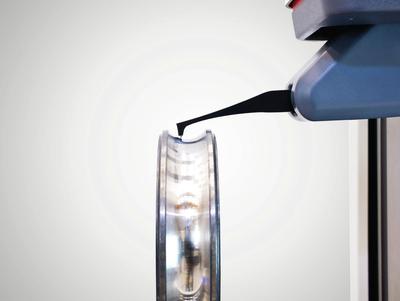
Versatili ed efficienti nella sala metrologica e in laboratorio
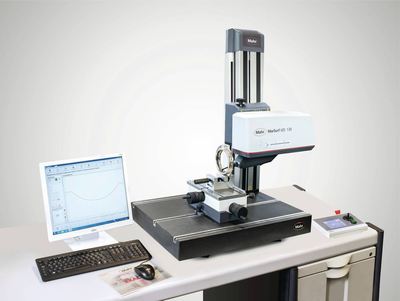


Misure di rugosità e profili 2D combinate: il professionista per tutte le applicazioni

Stazioni di misura a contatto per misurazioni di rugosità e profili 2D

Misure di rugosità e di profili 2D/3D secondo ISO 25178 / ISO 4287

Rugosimetri 3D per l'industria e la ricerca

Con gli strumenti di misura portatili potete misurare ovunque!
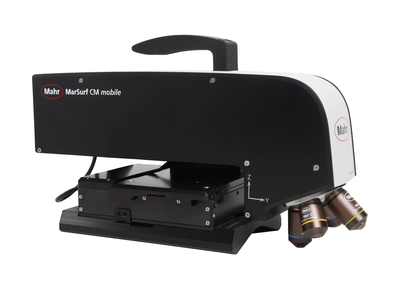
Rugosimetri 3D portatili da
utilizzare sul posto

Gli strumenti di misura portatili consentono sempre di misurare esattamente nel punto in cui è necessario ottenere i risultati.

Stazioni per la misura di ottiche altamente sensibili

Quando lo standard non basta più: soluzioni personalizzate in base alle esigenze del cliente
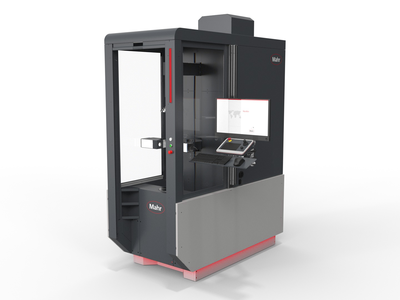
per cilindri
Scoprite le eccezionali caratteristiche di equipaggiamento coniugate a un'estrema flessibilità in termini di dimensioni dei pezzi e aumentate la produttività nell'ambiente di produzione.
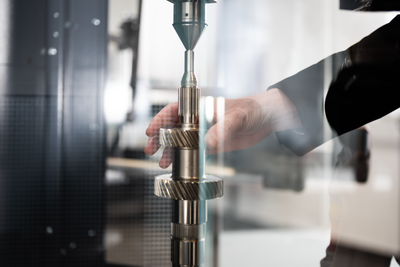
Flexible measurement of workpieces that can be clamped between centers

Telecamera a matrice ottica veloce abbinata a sistemi di tastatura ad alta precisione per la misura di numerose caratteristiche su pezzi a rotazione simmetrica.

Telecamera a matrice ottica veloce abbinata a sistemi di tastatura ad alta precisione per la misura di numerose caratteristiche su pezzi a rotazione simmetrica.

Flexible clamping options and high-precision alignment using a fully automatic centering and tilting table

Telecamera a matrice ottica veloce abbinata a sistemi di tastatura ad alta precisione per la misura di numerose caratteristiche su pezzi a rotazione simmetrica. Integrazione di una tavola completamente automatica di centraggio e basculamento per un allineamento meccanico estremamente rapido, possibilità di serraggio flessibili e anche ad es. misure interne.

Telecamera a matrice ottica veloce abbinata a sistemi di tastatura ad alta precisione per la misura di numerose caratteristiche su pezzi a rotazione simmetrica. Integrazione di una tavola completamente automatica di centraggio e basculamento per un allineamento meccanico estremamente rapido, possibilità di serraggio flessibili e anche ad es. misure interne.

Sistemi per la misura delle tolleranze di forma e posizione, come ad esempio rotondità, planarità, rettilineità o coassialità. Manuali o completamente automatizzati.
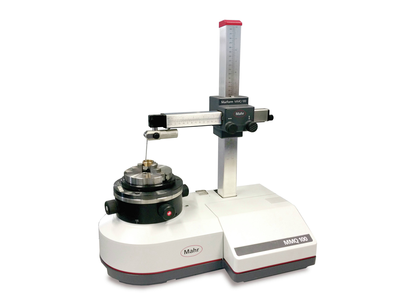
Misurate caratteristiche quali rotondità, rettilineità e oscillazione radiale in modo semplice, economico e con alta precisione. Le nostre macchine manuali di misura di forma sono adatte sia per la sala metrologica che per l'ambiente di produzione.
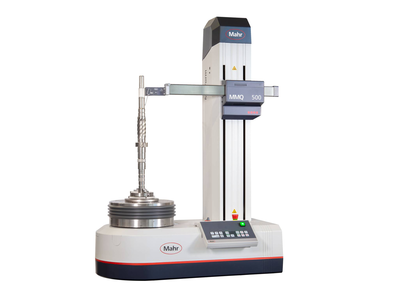
I nostri sistemi automatici di misura di forma consentono di ridurre i costi di processo senza aumentare i costi di valutazione – grazie a strumenti stabili e innovativi caratterizzati dal massimo grado di automazione, flessibilità e precisione.

per cilindri
Scoprite le eccezionali caratteristiche di equipaggiamento coniugate a un'estrema flessibilità in termini di dimensioni dei pezzi e aumentate la produttività nell'ambiente di produzione.
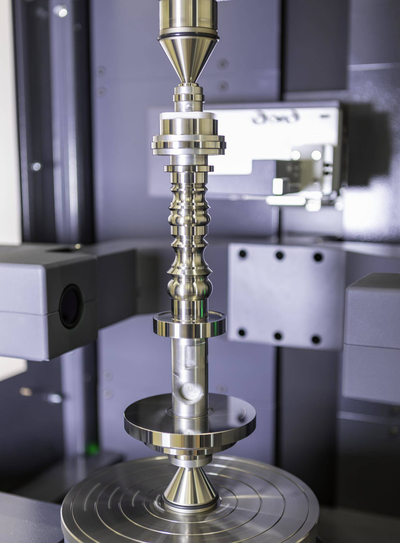
Flexible measurement of workpieces that can be clamped between centers

Flexible clamping options and high-precision alignment using a fully automatic centering and tilting table

Dispositivi di misura alberi ottici e a contatto per l'uso in ambienti di produzione difficili. Misurazione completa di tutti i comuni pezzi simmetrici all'asse di rotazione.

Macchine ottiche di misura alberi universali, completamente automatiche e robuste per l'uso in ambienti di produzione difficili.
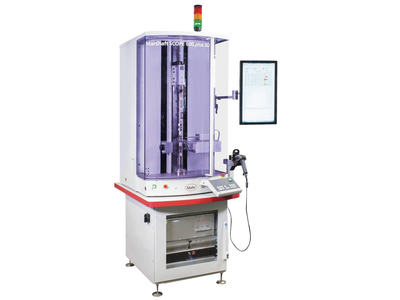
Macchine di misura alberi ottici/a contatto per l'uso in ambienti di produzione difficili. Misura completa di tutti i comuni pezzi simmetrici all'asse di rotazione.

per cilindri
Scoprite le eccezionali caratteristiche di equipaggiamento coniugate a un'estrema flessibilità in termini di dimensioni dei pezzi e aumentate la produttività nell'ambiente di produzione.

Flexible measurement of workpieces that can be clamped between centers

Flexible clamping options and high-precision alignment using a fully automatic centering and tilting table

Analisi altamente specializzate di ingranaggi o misure in serie completamente integrate – Mahr è il vostro partner a tutti i livelli della moderna produzione di ingranaggi e ruote dentate.
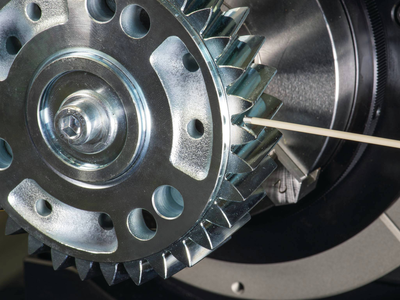
Misurare proprio laddove nasce il prodotto – con un rapido feedback sul processo di produzione per evitare scarti.


Ampia gamma di tecnologie e prodotti per il rilevamento veloce senza contatto di superfici e geometrie.

I microscopi sono utilizzati in quasi tutti i settori per il controllo rapido di distanze, raggi e angoli. In laboratorio o in ambiente di produzione.

Determinazione della rugosità, dei profili 2D e di molti altri parametri di superficie.

Rugosimetri per l'industria e la ricerca

Minime rugosità con precisione nanometrica

Analisi ottica di geometrie e topografie di superficie

Sistemi revisionati di comprovata qualità Mahr

Touch operation, ergonomic handling and a wide range of evaluation options: This is what the Digimar 816 CLT height measuring device stands for.
3 professional tips: This is how form measurement works
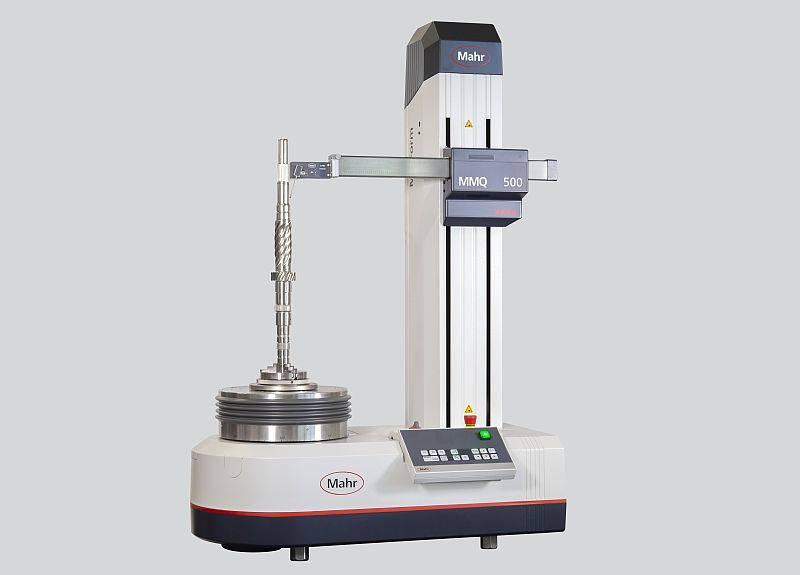
Tip 1: Apply correct filters
In order for you to evaluate the measurement data correctly, the selection of the correct filters in the software is an essential prerequisite. However, if an in-house standard or filter settings aren’t provided, we advise the following: First decide which measurement task you want to perform with your form measuring machine - the inspection of surface roughness or a form measurement. If you want to check the surface roughness of a workpiece, use the data with short wavelength for the analysis, while discarding those with long wavelength. For a form measurement, filter and evaluate the data with long wavelength, which refers to the form, and you can discard the data with short wavelength.
However, with the two described measuring tasks, you have to consider further differences. To measure surface roughness, the filter settings are defined in terms of millimeters or inches. For example, if you set the filter to 0.8 mm, this means that surface deviations of less than 0.8 mm are accepted as surface roughness, while elements of more than 0.8 mm are not included in the result.
In contrast, shape filters for roundness measurements, for example, are usually specified as an angular size, but not in angular degrees, rather in a unit known as "waves per revolution" or UPR for short. Many users choose 50 UPR as the default value. This means that the arc length is 1/50 of a circle or a section on the surface of a round object, which corresponds to 7.2 degrees. However, the arc length changes analogously to the diameter of the workpiece.
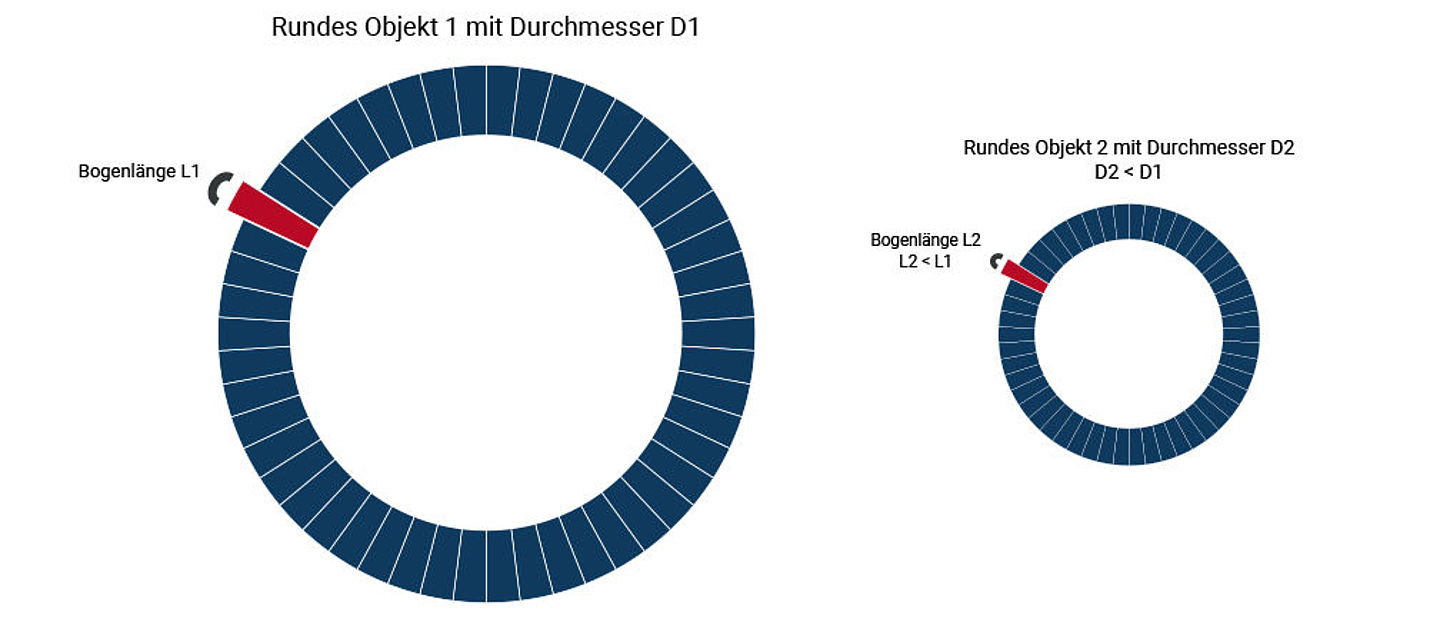
Therefore, you must always select the correct filter depending on the diameter and the subsequent function of the workpiece. Depending on the choice of filter, shape defects can contain only coarse components (workpiece is oval or "three-sided equal thickness") or also finer components such as higher-frequency waviness.
You can obtain further tips on the correct choice of filter depending on diameter and application, for example, in the training courses of the Mahr Academy or during a training session directly at your Mahr formtester.
Tip 2: Choose the right probe size
When selecting the probe, you must take into account the dimensions of the component to be tested. This is because the sensing ball at the tip of the sensing element is itself a mechanical filter. The probe must therefore correspond to the workpiece size and the maximum measurable number of waves per revolution. If a probe element that is too large travels on the measuring surface, it cannot optimally plunge into all valleys of the real profile. As a result, the unsuitable probe causes unwanted mechanical filtering of the data, which falsifies the measurement results.
Incidentally, the VDI/VDE Society for Measurement and Automation Technology can advise you on the selection criteria for the correct probe element: its guideline VDI/VDE 2631 "Form Measurement Basics" sheet 3 contains a guide on how to select and use the correct probe element. With the MarForm MMQ 500, the use of the correct probe element is very convenient: Its probe arm unit holds up to four probe arms at once and changes them quickly and fully automatically depending on the measuring task and without any operator intervention.
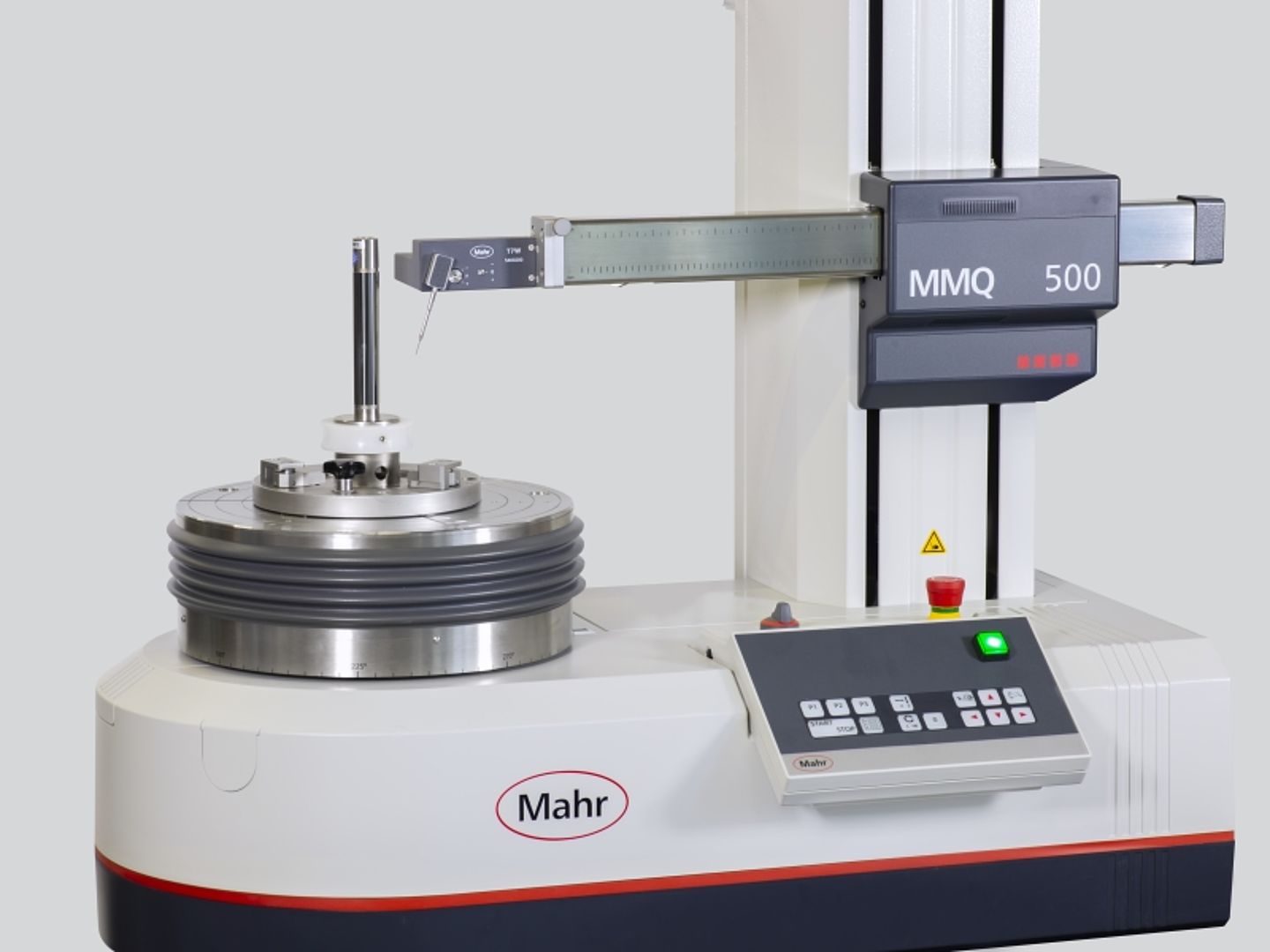
Tip 3: Align workpiece precisely
Before you can measure the form and position characteristics of a workpiece with a formtester, you must first align it: With the help of the tilting and centering table, you tilt and center it so that the axis of the workpiece and the axis of rotation of the formtester coincide. This prevents you from measuring supposed shape defects that are not there. For example, if the alignment is incorrect, a cut through an inclined cylinder may incorrectly show up as an ellipse rather than a circle. In addition, correct alignment prevents the probing point, which ideally lies exactly in the X-Z plane, from wandering during the measurement.
With formtester that have an automatic tilting and centering table, like the MarForm MMQ 500, you can control alignment errors very well: Due to the high precision during alignment, you can neglect contributions to errors in roundness measurement. For example, a typical residual eccentric of 5 µm on a cylinder with an outer diameter of 50 mm leads to an additional roundness deviation of less than one nanometer. For other features, especially those relating to position, or components with small diameters, the influence of alignment errors may be greater. However, it is also true here that you can keep this negligibly small by exact alignment.
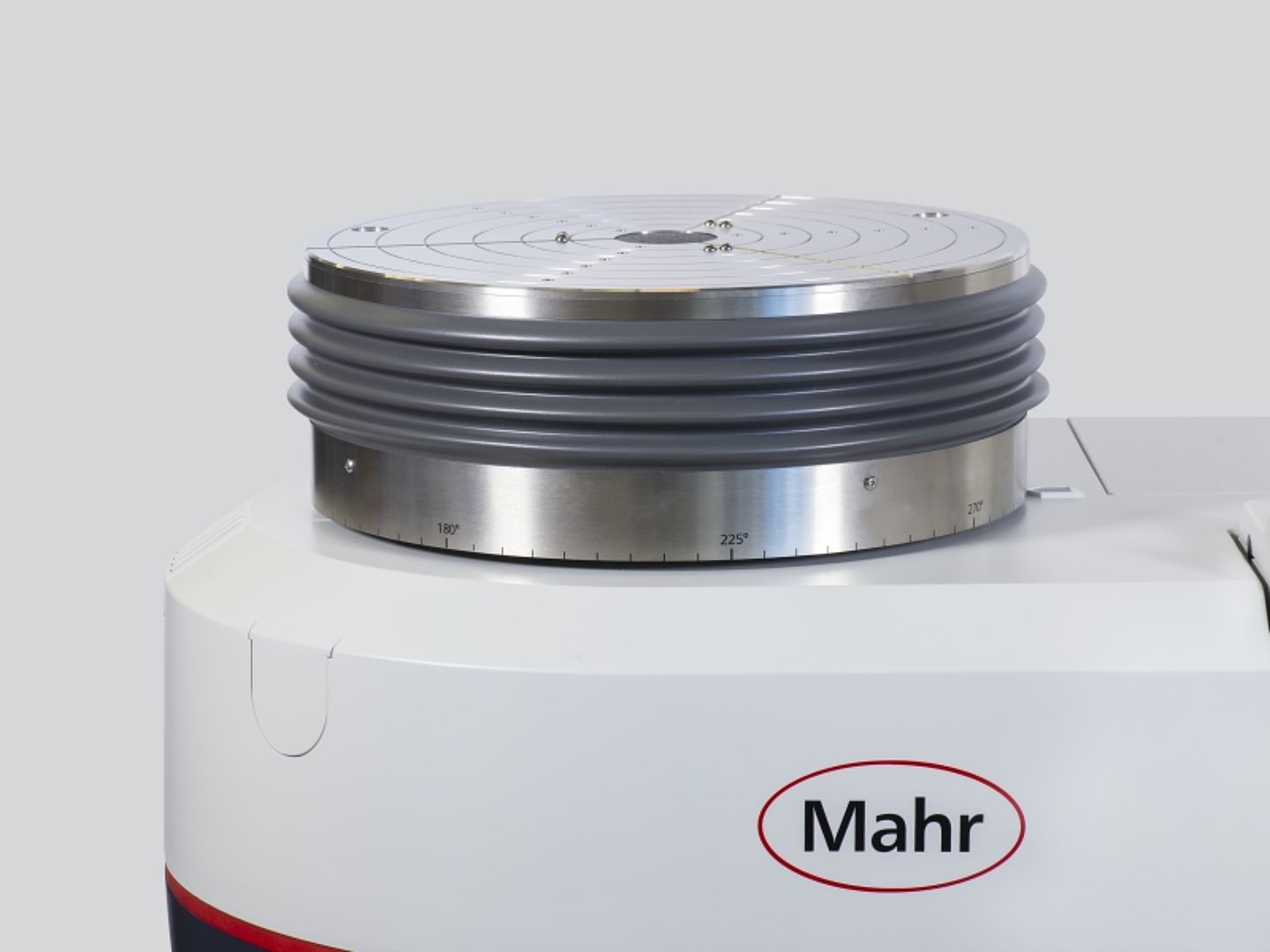
In practice, therefore, two fundamental questions arise during alignment:
1. Where, i.e. at which points on the workpiece, should alignment take place?
2. How precisely should the workpiece be aligned?
If a workpiece has a main reference, you should always align to this reference. If there is no main reference, it makes sense to align at the points with the smallest tolerances. It is recommended to limit the skew to ten times the numerical value of the residual eccentric (5 µm residual eccentric at 50 µm/m permissible inclination). Then no problems will arise from the remaining skew, regardless of the distance between the measured circles.
For many measuring tasks, the residual eccentric of 5 µm stored as the default value in the MarWin software is absolutely sufficient. The Mahr formtesters usually achieve this quickly and reliably, so you should not use larger values. For small tolerances (e.g. 1 µm roundness, 5 µm cylindricity or 5 µm concentricity) or for components with small diameters (10 mm and smaller), it is advisable to reduce the permitted residual eccentric. With the new MarForm MMQ 500 formtester, you can align your components reliably and quickly even to the smallest of residual eccentrics.
